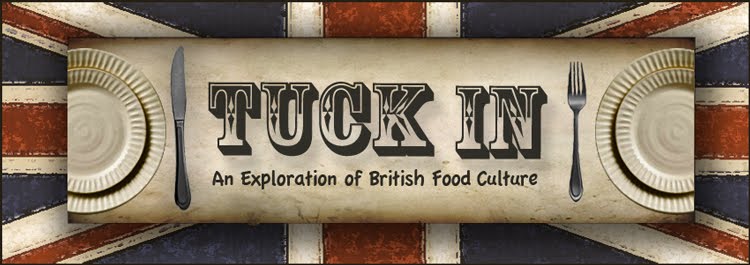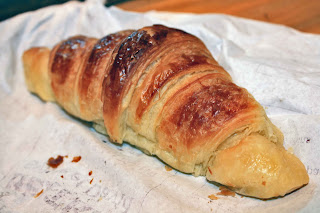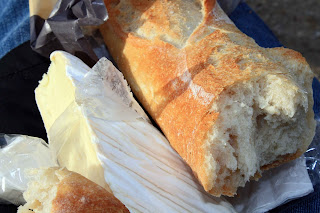When I came to the U.K., I was really looking forward to trying the cheese here, and I think I know why. It all stems from the English animation Wallace and Gromit because in any of these videos, the indulgent Wallace sneaks into the refrigerator for a nice slab of cheese. He takes a trek to the moon too to find out if it’s really made of cheese and invents an alarm clock made for him that, rather than equipped with an annoying ring, uses a robotic arm to place a plate of cheese in front of his nose, waking him with the lovely aroma. And try as he may, poor Gromit never really seems to be able to cure Wallace of his unhealthy obsession with Cheddar, no matter how many carrots he bribes him with. So if Wallace finds English cheese so enticing, then I of course had to try it.
So although these may be silly examples, they really do show the importance of cheese in the English diet and the pride they take in their variety of cheeses. Almost every region in England has its special kind and they all come together in the cheese shops of London, available for my tasting pleasure. As I walked into Neal’s Yard Dairy, a very renowned traditional British cheese shop and also the first cheese shop I’ve ever visited, the first sense that I couldn’t help but pay attention to was my nose. I could actually detect hints of the shop’s presence way before it came into my line of sight but once inside, my nostrils were filled to the brim with an aroma that was both very pleasing yet revolting. Despite its slightly moldy notes, due to the briny rinds that encased most of the cheese, there were hints of nuttiness and a sort of earthy mushroom scent.
It actually grew on me very fast so that before long, my nose was no longer begging for my attention and my other senses could participate again. The shop was very chilly and dry and for understandable reasons because what I saw was quite a unique sight. There was literally nothing but a long counter stacked up high with enormous rounds of cheese, all sitting out in the open with no refrigeration and each accompanied by a hand written labels. And on top of each stack sat a large wedge of the same variety from which the cheesemongers could cut off slices for the consumer. The workers in the shop were very friendly too, most obligingly letting me involve my tasting senses and sample any of the beautiful cheese before me. So, although I have only bought a handful of their varieties, I have tried many more and will now give you a very brief guide to the varieties of English cheese.
 Maybe the most renowned of all English cheeses is cheddar. Although America has many of its own varieties, cheddar originated in the U.K., more specifically in Somerset. The cool climate there was good for the maturing process, which was done in the caves in the town of Cheddar. The cheese has been made in Somerset since the late 1100s and was the top choice among royals for their banquets. It has varying maturing times too. Those that age for a short time are mild and creamy and if matured longer, develop much sharper, stronger, and nuttier flavors. Aged cheddar takes on a harder and crumblier texture with slightly crystallized bits that crunch as its chewed too. Since I’ve been shopping at Neal’s Yard, I’ve had their Keen’s cheddar, a raw cow’s milk and very aged cheese from Somerset. It is possibly the most traditional of the cheddars made today and has a strong, tangy flavors with a rich and crumbly mouth feel. It’s the perfect cheese to use for a Ploughman’s Lunch, a traditional British pub lunch that includes a hunk of bread, a slab of cheddar, apple slices, pickled onions, Branston pickle, and sometimes a hardboiled egg, all one a plate together. It makes for a filling, sweet and salty lunch that really benefits from the strong punch of the cheese.
Maybe the most renowned of all English cheeses is cheddar. Although America has many of its own varieties, cheddar originated in the U.K., more specifically in Somerset. The cool climate there was good for the maturing process, which was done in the caves in the town of Cheddar. The cheese has been made in Somerset since the late 1100s and was the top choice among royals for their banquets. It has varying maturing times too. Those that age for a short time are mild and creamy and if matured longer, develop much sharper, stronger, and nuttier flavors. Aged cheddar takes on a harder and crumblier texture with slightly crystallized bits that crunch as its chewed too. Since I’ve been shopping at Neal’s Yard, I’ve had their Keen’s cheddar, a raw cow’s milk and very aged cheese from Somerset. It is possibly the most traditional of the cheddars made today and has a strong, tangy flavors with a rich and crumbly mouth feel. It’s the perfect cheese to use for a Ploughman’s Lunch, a traditional British pub lunch that includes a hunk of bread, a slab of cheddar, apple slices, pickled onions, Branston pickle, and sometimes a hardboiled egg, all one a plate together. It makes for a filling, sweet and salty lunch that really benefits from the strong punch of the cheese. England of course is also known for its bleu cheese and although France may have it Roquefort, Britain has Stilton, a delicacy and an absolute pleasure to eat. It is even called the “King of English cheeses”. It’s believed that Stilton originated in the early 1700s in the village of Stilton and was originally made by letting blocks of cream cheese age for a very long time. Today Stilton has certification trademark and Designation of Origin status so it can only be produced Nottinghamshire, Derbyshire, and Leicestershire.
England of course is also known for its bleu cheese and although France may have it Roquefort, Britain has Stilton, a delicacy and an absolute pleasure to eat. It is even called the “King of English cheeses”. It’s believed that Stilton originated in the early 1700s in the village of Stilton and was originally made by letting blocks of cream cheese age for a very long time. Today Stilton has certification trademark and Designation of Origin status so it can only be produced Nottinghamshire, Derbyshire, and Leicestershire. Neal’s Yard sells Colston Bassett Stilton from Nottinghamshire. Neal’s Yard also produces its own bleu cheese called Stichelton that is rapidly becoming a recognized and well-liked British bleu. Bleu cheese, of course, is the most easily recognizable with its cream colored interior flecked with dark bluish-green veins. And although its appearance may scare some, it is an absolutely delicious cheese, actually quite mild yet still fruity and tangy. The texture, especially of the Stilton, is literally as creamy as butter and crumbles into millions of pieces as it’s cut. Bleu, because of its sweet notes, is often served as a dessert with red wine or paired with red fruit flavors like plum.
There are many other popular British cheeses as well with varying colors, tastes, strengths of flavors, and textures. Cheshire cheese (the one pictured), which I bought due to the mere fact that I had been to the pub taking this name, is another hard and strong cheese, very crumbly in texture, slightly metallic in flavor, and dyed with annatto, giving it an orange color. Lancashire cheese has a very buttery taste with acidity like yogurt. It is smooth and creamy yet crumbly in the mouth. And, Red Leicester, also easily recognizable due to its bright orange and red hue, has been around since the 17th century. The color comes from the annatto dye but also takes on the orange because the milk from which Red Leicester is made comes from cows with a diet high in beta carotene. This cheese is rich, sweet and much more chewy than crumbly.
Finally, a very interesting a somewhat gimmicky cheese is a little thing called Stinking Bishop. The rind itself really does stink …bad…and has to be well wrapped in the refrigerator to prevent it from becoming a toxic zone. But, the inside is really goopy and creamy, like brie. It is speckled with these little holes, has this slightly sticky and gelatinous texture, and the taste is absolutely mild like cream or butter. Funnily enough, in Wallace and Gromit, Curse of the Were Rabbit, its smell was used to revive Wallace from the dead.
I have really enjoyed my cheese tasting since I’ve been here and always look forward to picking up something new every time I return to Neal’s Yard. To end this post on a fun note, I will share a particularly tasty cheese experience at Borough Market. One of the food stalls is Kappacasein and they sell this very interesting Swiss dish called Raclette, but turned English with a Ogleshield Cheese from Somerset. Essentially, they take half a round of the cheese, place it under a blue flame until the cheese is slightly burnt and bubbling. Then, they pick it up and use a knife to scrape the melted top layer over a plate of boiled potatoes, pickled onions, and gherkins. It’s absolutely sinful to eat but it is very disappointing to look down mere minutes later and find it gone.

















































